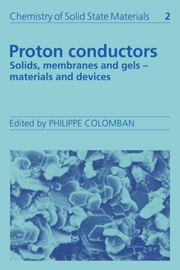Book contents
- Frontmatter
- Contents
- List of contributors
- Preface
- Symbols
- I HYDROGEN BOND AND PROTONIC SPECIES
- II MATERIALS: PREPARATION, STRUCTURES AND PROPERTIES
- III PROTON DYNAMICS AND CHARGE TRANSPORT
- IV PROTON DIFFUSION MECHANISMS
- V DEVICES
- 32 Applications of perfluorinated proton conductors (Nations)
- 33 Synthesis of polycrystalline H3O+ and NH4+ -β″/β-Al2O3 and potential applications in steam-electrolysis/fuel-cells
- 34 Fuel-cells, steam-electrolysis for hydrogen production and hydrogen separation using high temperature protonic conductors
- 35 Ice-based devices
- 36 Solid-state gas sensors operating at room temperature
- 37 All solid-state protonic batteries
- 38 Applicatios of proton conductors in electrochromic devices (ECDs)
- 39 Supercapacitors and interfacial charge accumulation devices
- Index
36 - Solid-state gas sensors operating at room temperature
Published online by Cambridge University Press: 04 May 2010
- Frontmatter
- Contents
- List of contributors
- Preface
- Symbols
- I HYDROGEN BOND AND PROTONIC SPECIES
- II MATERIALS: PREPARATION, STRUCTURES AND PROPERTIES
- III PROTON DYNAMICS AND CHARGE TRANSPORT
- IV PROTON DIFFUSION MECHANISMS
- V DEVICES
- 32 Applications of perfluorinated proton conductors (Nations)
- 33 Synthesis of polycrystalline H3O+ and NH4+ -β″/β-Al2O3 and potential applications in steam-electrolysis/fuel-cells
- 34 Fuel-cells, steam-electrolysis for hydrogen production and hydrogen separation using high temperature protonic conductors
- 35 Ice-based devices
- 36 Solid-state gas sensors operating at room temperature
- 37 All solid-state protonic batteries
- 38 Applicatios of proton conductors in electrochromic devices (ECDs)
- 39 Supercapacitors and interfacial charge accumulation devices
- Index
Summary
Introduction
Some proton conductors have relatively high conductivities at room temperature. Introduction of these materials into electrochemical cells brings about attractive chemical sensors workable at room temperature. Potentiometric or amperometric detection of chemical components at room temperature would create new fields of application for sensors especially in bioprocess control and medical diagnosis. With an all-solidstate structure, the sensors would be compatible with micro-fabrication and mass production, and small power consumption associated with their ambient-temperature operation would be intrinsically suited for cordless or portable sensors.
As listed in Table 36.1, a good deal of research has been carried out so far on proton conductor-based gas sensors workable at ambient temperature. Various inorganic and organic ion exchangers, such as hydrogen uranyl phosphate (HUP), zirconium phosphate (ZrP), antimonic acid (AA), and NAFION membrane, have been utilized in the form of a disc, thick- or thin-film. The ionic conductivities of these proton conductors, in the range 10–4 – 10–2 S cm–1, are modest but seem to be still sufficient for chemical sensing devices.
A problem with these conductors is that humidity in the ambient atmosphere affects the conductivities and hence sensing characteristics when an amperometric mode of operation is adopted, as described later. The sensing electrodes have been provided mostly by Pt, and the counter electrodes by Ag, PdHx, TiHx, H0.35MoO3, Hx WO3, etc.
- Type
- Chapter
- Information
- Proton ConductorsSolids, Membranes and Gels - Materials and Devices, pp. 527 - 538Publisher: Cambridge University PressPrint publication year: 1992
- 3
- Cited by



